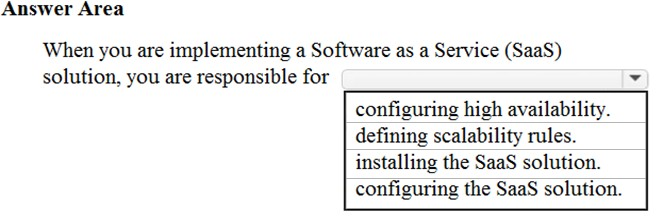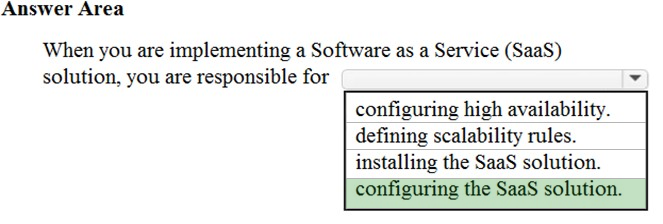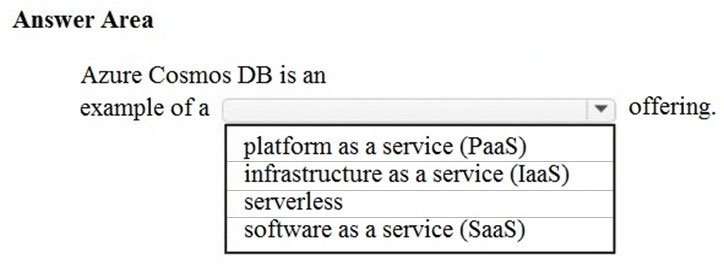AZ-900: Microsoft Azure Fundamentals
You're developing an application and want to focus on building, testing, and deploying. You don't want to worry about managing the underlying hardware or software. Which cloud service type is best for you?
Infrastructure as a Service (IaaS)
Software as a Service (SaaS)
Platform as a Service (PaaS)
Answer is Platform as a Service (PaaS)
Platform as a Service is the best choice here because the PaaS services handle the IT management tasks for you, so you can focus on writing code.
For each of the following statements, select Yes if the statement is true. Otherwise, select No.


Box 1: No
A PaaS solution does not provide access to the operating system. The Azure Web Apps service provides an environment for you to host your web applications.
Behind the scenes, the web apps are hosted on virtual machines running IIS. However, you have no direct access to the virtual machine, the operating system or IIS.
Box 2: Yes
A PaaS solution that hosts web apps in Azure does provide the ability to scale the platform automatically. This is known as autoscaling. Behind the scenes, the web apps are hosted on virtual machines running IIS. Autoscaling means adding more load balanced virtual machines to host the web apps.
Box 3: Yes
PaaS provides a framework that developers can build upon to develop or customize cloud-based applications. PaaS development tools can cut the time it takes to code new apps with pre-coded application components built into the platform, such as workflow, directory services, security features, search and so on.
References:
https://azure.microsoft.com/en-gb/overview/what-is-paas/
To complete the sentence, select the appropriate option in the answer area.


When you are implementing a Software as a Service (SaaS) solution, you are responsible for configuring the SaaS solution. Everything else is managed by the cloud provider.
SaaS requires the least amount of management. The cloud provider is responsible for managing everything, and the end user just uses the software.
Software as a service (SaaS) allows users to connect to and use cloud-based apps over the Internet. Common examples are email, calendaring and office tools (such as Microsoft Office 365).
SaaS provides a complete software solution which you purchase on a pay-as-you-go basis from a cloud service provider. You rent the use of an app for your organization and your users connect to it over the Internet, usually with a web browser. All of the underlying infrastructure, middleware, app software and app data are located in the service providerג€™s data center. The service provider manages the hardware and software and with the appropriate service agreement, will ensure the availability and the security of the app and your data as well.
Reference:
https://azure.microsoft.com/en-in/overview/what-is-saas/
https://docs.microsoft.com/en-gb/learn/modules/principles-cloud-computing/5-types-of-cloud-services
For each of the following statements, select Yes if the statement is true. Otherwise, select No.


Box 1: No
It is not true that a company must always migrate from a private cloud model to implement a hybrid cloud. You could start with a public cloud and then combine that with an on-premise infrastructure to implement a hybrid cloud.
Box 2: Yes
A company can extend the capacity of its internal network by using the public cloud. This is very common. When you need more capacity, rather than pay out for new on-premises infrastructure, you can configure a cloud environment and connect your on-premises network to the cloud environment by using a VPN.
Box 3: No
It is not true that only guest users can access cloud resources. You can give anyone with an account in Azure Active Directory access to the cloud resources.
There are many authentication scenarios but a common one is to replicate your on-premises Active Directory accounts to Azure Active Directory and provide access to the Azure Active Directory accounts. Another commonly used authentication method is Federation where authentication for access to cloud resources is passed to another authentication provider such as an on-premises Active Directory.
Reference:
https://azure.microsoft.com/en-gb/overview/what-is-hybrid-cloud-computing/
You plan to migrate several servers from an on-premises network to Azure.
What is an advantage of using a public cloud service for the servers over an on-premises network?
The public cloud is owned by the public, NOT a private corporation
The public cloud is a crowd-sourcing solution that provides corporations with the ability to enhance the cloud
All public cloud resources can be freely accessed by every member of the public
The public cloud is a shared entity whereby multiple corporations each use a portion of the resources in the cloud
Answer is The public cloud is a shared entity whereby multiple corporations each use a portion of the resources in the cloud
The public cloud is a shared entity whereby multiple corporations each use a portion of the resources in the cloud. The hardware resources (servers, infrastructure etc.) are managed by the cloud provider. Multiple companies create resources such as virtual machines and virtual networks on the hardware resources.
Incorrect Answers:
A: The public cloud is not owned by the public. In the case of Microsoft Azure, the cloud is owned by Microsoft.
B: The public cloud is a not crowd-sourcing solution. In the case of Microsoft Azure, the cloud is owned by Microsoft.
C: It is not true that public cloud resources can be freely accessed by every member of the public. You pay for a cloud subscription and create accounts for your users to access your cloud resources. No one can access your cloud resources until you create user accounts and provide the appropriate access permissions.
In which type of cloud model are all the hardware resources owned by a third-party and shared between multiple tenants?
private
hybrid
public
Answer is public
Microsoft Azure, Amazon Web Services and Google Cloud are three examples of public cloud services. Microsoft, Amazon and Google own the hardware. The tenants are the customers who use the public cloud services.
You have 50 virtual machines hosted on-premises and 50 virtual machines hosted in Azure. The on-premises virtual machines and the Azure virtual machines connect to each other.
Which type of cloud model is this?
hybrid
private
public
Answer is hybrid
References:
https://azure.microsoft.com/en-gb/overview/what-is-hybrid-cloud-computing/
To complete the sentence, select the appropriate option in the answer area.


Azure Cosmos DB is an example of a platform as a service (PaaS) cloud database provider.
Reference:
https://docs.microsoft.com/en-us/azure/cosmos-db/database-security
To complete the sentence, select the appropriate option in the answer area.

Answer is in the public cloud
A private cloud is hosted in your datacenter. Therefore, you cannot close your datacenter if you are using a private cloud.
A public cloud is hosted externally, for example, in Microsoft Azure. An organization that hosts its infrastructure in a public cloud can close its data center.
Public cloud is the most common deployment model. In this case, you have no local hardware to manage or keep up-to-date ג€" everything runs on your cloud provider's hardware.
Microsoft Azure is an example of a public cloud provider.
In a private cloud, you create a cloud environment in your own datacenter and provide self-service access to compute resources to users in your organization.
This offers a simulation of a public cloud to your users, but you remain completely responsible for the purchase and maintenance of the hardware and software services you provide.
Reference:
https://docs.microsoft.com/en-gb/learn/modules/principles-cloud-computing/4-cloud-deployment-models
What does a customer provide in a software as a service (SaaS) model?
application data
data storage
compute resources
application software
Answer is application data
SaaS provides a complete software solution which you purchase on a pay-as-you-go basis from a cloud service provider. You rent the use of an app for your organization and your users connect to it over the Internet, usually with a web browser. All of the underlying infrastructure, middleware, app software and app data are located in the service providerג€™s data center. The service provider manages the hardware and software and with the appropriate service agreement, will ensure the availability and the security of the app and your data as well.
Reference:
https://azure.microsoft.com/en-in/overview/what-is-saas/